Ground covers are low-growing plants that spread quickly to form a dense cover. They add beauty to the landscape and at the same time help prevent soil erosion. Grass is the best known ground cover, but grass is not suited to all locations. Other ground cover plants should be used where grass is difficult to grow or maintain.
Unlike grass, most ground cover plants cannot be walked on. They can be used effectively to reduce maintenance work and to put the finishing touch on any landscaping project.
Location
Ground covers can be found to fit many conditions, but they are used most frequently for the following locations:
- Steep banks or slopes.
- Shady areas under trees and next to buildings.
- Underplantings in shrub borders and beds.
- Areas where tree roots grow close to the surface and prevent grass from growing.
- Locations that are very wet or very dry.
When planted under trees, ground covers reduce the possibility of mower damage to the base of the tree. Some ground covers may be used to protect the roots of shallow-rooted trees. They shade the soil and keep it from drying out rapidly. Some ground covers don’t require as much moisture and nutrients as grass. Therefore, they are in less competition with trees and shrubs.
Selection
Selection of a suitable plant for ground cover depends on the area where it will be grown. Some ground cover plants prefer partial shade, others thrive in deep shade or full sun; a few grow well in either sun or shade. The selected ground cover plants listed here grow well in a wide variety of soil types. Some, however, prefer moist soil while others need dry or well-drained soil. All the ground covers discussed are reliably cold hardy throughout Missouri.
First, select types best suited to the conditions existing where the ground cover is needed. From these selected types, choose one that ornamentally blends best with surrounding plantings.
Table 1. Area covered by 100 plants at different planting distances.
| Planting distance | Area covered |
|---|---|
| 4 inches | 11 square feet |
| 6 inches | 25 square feet |
| 8 inches | 44 square feet |
| 10 inches | 70 square feet |
| 12 inches | 100 square feet |
| 18 inches | 225 square feet |
| 24 inches | 400 square feet |
| 36 inches | 900 square feet |
| 48 inches | 1,600 square feet |
Culture
A well-prepared planting bed is necessary to develop a dense, healthy ground cover planting. The soil should be worked to a depth of 6 to 8 inches. Take care to eliminate perennial weeds and grass that might compete with the ground cover during establishment.
Organic materials such as peatmoss, leaf mold, compost or well-rotted manure lighten clay soils and improve the water-holding capacity of sandy soils. Eight to 10 bushels of organic materials per 100 square feet incorporated to a depth of 6 to 8 inches may be necessary in very poor or heavy soils.
A soil test provides the best guidance for fertilizer usage. Without this information, a general rule would be to use three pounds of a commercial fertilizer such as 5-10-5 per 100 square feet. Mix the fertilizer into the soil to a depth of 6 to 8 inches.
Most ground cover plants can be planted any time during the growing season, but either spring or fall is preferred.
The arrangement and spacing of plants in the planting bed depends on the growth characteristics of the plant. Space plants so they will develop a uniformly covered area in a relatively short period of time.
Plants that spread rapidly may be spaced much wider than slow-spreading types. Spacing also depends on funds available and how quickly a complete cover is wanted. Spacings from 1 to 2 feet apart are most frequently used. Table 1 suggests the area that approximately 100 plants will cover when set at various distances. For example, if plants are spaced 4 inches apart, 100 plants will cover about 11 square feet. A staggered row planting pattern usually will result in the quickest cover of the planting bed.
Watering, weeding, mulching and feeding will be the main requirements of the new ground cover planting. Water during dry periods. An occasional thorough soil soaking is better than frequent light waterings. Occasional hand weeding with a minimum disturbance of the soil may be necessary. A one-inch mulch layer of peatmoss, compost or similar organic material applied between plants will conserve soil moisture and reduce weed growth. An annual spring application of a 5-10-5 or similar analysis fertilizer at the rate of 3 pounds per 100 square feet is recommended to maintain vigorous growth.
RECOMMENDED GROUND COVERS
Barrenwort (Epemedium)
The epemediums are a group of low-growing perennials that are very effective as ground covers in shade. They grow about a foot tall in clumps and have attractive, often colorful, heart-shaped, serrate leaves. They bloom in spring with clusters of delicate flowers resembling tiny columbine blooms. Epemediums tolerate sun but prefer shade and bloom well in mulched beds under trees. Red epemedium (E. x rubrum), one of the most commonly planted types, has an excellent bronze-purple fall color.
Bearberry (Arctostaphylos uva-ursi)
Bearberry is a woody evergreen plant that stays less than 12 inches tall, but can spread up to 6 feet. It roots at the nodes and gradually forms a dense mat of small, glossy leaves that turn purplish in winter. Flowers in spring are tiny, pink and bell-shaped, like those of heather or blueberry. Although it does not reliably produce fruit in Missouri’s climate, when it does, the bright red berries persist, adding winter interest.
Bearberry prefers a sandy or rocky, acidic soil and full sun or partial shade. Excellent drainage is a must, but irrigation during drought conditions may be necessary. Where irrigation is not practical, afternoon shade will help get this plant through the summer heat in good condition.
Blood-red cranesbill (Geranium sanguineum)
Several species of geraniums, often called wild geranium or cranesbill, make effective ground cover plants. Cranesbill differs considerably from the common garden geranium (Pelargonium) in that they are cold hardy, herbaceous perennials. One of the best species of Geranium for ground cover purposes is G. sanguineum, blood-red cranesbill. Growing 12 to 14 inches tall, it has attractive, dark green foliage and numerous 1-inch red, pink or purple flowers (depending on cultivar) in late spring. It tolerates full sun and drought but also grows in partial shade. It works well as a ground cover border in a perennial bed.
Candytuft (Iberis sempervirens)
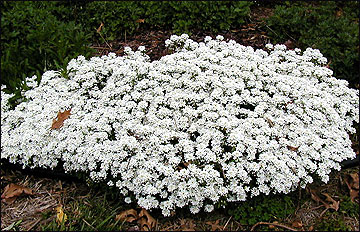 Figure 1. Candytuft (Iberis sempervirens).
Figure 1. Candytuft (Iberis sempervirens).
Candytuft is an excellent ground cover for the border of a perennial garden in full sun. Growing about 12 inches tall, it has small, dark green, evergreen leaves and produces a carpet of pure white flowers in spring (Figure 1). Candytuft prefers full sun and well-drained soil. It benefits from cutting back after flowering to maintain compactness.
Coralbells (Heuchera sanguinea)
Coralbells is an excellent ground cover for partial shade. It produces rosettes of rounded basal leaves near the ground but blooms nearly all summer long, sending up foot-long graceful flower stalks bearing clusters of colorful, bell-shaped flowers well above the foliage. Coralbells grows best in a moist, fertile, but well drained soil with high organic matter. Partial shade and irrigation are necessary to keep this ground cover in good condition during heat and drought.
Creeping juniper (Juniperus sp.)
Several juniper species are naturally low-growing, and other species include selected low-growing varieties (cultivars) that make excellent ground covers for sunny, well-drained locations. They range in height from about 6 inches to about 2 feet, depending upon cultivar. These vigorous growers are tolerant of fairly poor soils and can spread to cover an area from 6 to 8 feet. They are suitable for sunny slopes or banks where an evergreen ground cover is desired.
Juniper leaves are short, needle-shaped and, depending on variety, may be green or blue-green. Needles may change from their summer color to a purplish or slate color in winter. Spacing of plants depends on how quickly cover is wanted, but generally junipers for ground cover should be spaced 2 to 4 feet apart. Many cultivars of Juniperus horizontalis have been developed. Some of the lowest growing of these include ‘Emerald Isle’, ‘Prince of Wales’ and ‘Wiltoni’, also known as Blue Rug. These cultivars grow to a height of 6 to 8 inches. Slightly taller cultivars include ‘Bar Harbor’, ‘Hughes’ and ‘Youngstown’, which may reach about a foot in height.
Another species providing some very low growing cultivars is Juniperus procumbens. Two cultivars from this species in the 6- to 8-inch height range are ‘Nana’ and ‘Greenmound’.
For locations where taller ground covers may be desired, cultivars of Juniperus sabina might be selected. Two popular cultivars from this juniper species are ‘Broodmoor’ and ‘Skandia’. These cultivars grow to a height of 1-1/2 to 2 feet.
Although junipers are widely adapted, there are some species more suited to cooler or warmer conditions. Among the low-growing types, a variety that has become quite popular is ‘Blue Star’, which grows to a height of about 2 feet. It belongs to Juniperus squamata, a species best suited to cooler climates. From this species, and requiring the same conditions, the variety 'Blue Carpet' is also very attractive and grows only to a height of about 1 foot.
In warmer areas of the state, several cultivars of the shore juniper, Juniperus conferta, might be selected for a looser, textural change of ground cover. Possible choices include ‘Boulevard’, ‘Emerald Sea’ and ‘Blue Pacific’.
Creeping phlox, Moss pink (Phlox subulata)
Creeping phlox is commonly used as a rock garden plant but forms an effective ground cover on poor, bare soils where there is little competition. It forms a dense mat of moss-like foliage, which is covered in spring with masses of flowers in either pink, purplish or white . In rocky areas it will persist in the existing soil and drape itself over the stones. It is a plant for full sun and relatively dry soils. As plants age, they may tend to develop occasional dead spots. Periodic division to fill such spots may be necessary. In mild climates the plants are evergreen, but where winters are cold and plants are exposed, browning may occur.
Goldflame honeysuckle (Lonicera x heckrotii ‘Goldflame’)
Although some honeysuckles should not be used as ground covers because of prolific seed production, ‘Goldflame’ produces no fruit. It is a vigorous vine that forms loose mounds of blue-green foliage. Blooms in May start out with carmine red buds, which turn to pink and yellow as the flowers open, with a slight fragrance. After the initial spring bloom, ‘Goldflame’ will bloom sporadically throughout the summer and fall. This plant can be an attractive ground cover in a large bed. It should be mulched, because the foliage may not be dense enough to shade out all weeds.
Hosta, Funkia, Plantain Lily (Hosta spp.)
For shaded areas, hostas make effective ground covers. They appear most often in perennial borders as accent plants or edgings, but their large leaves provide a lush covering for the soil. Hosta species vary in size and foliage color. Some have deep-green, yellow-green or gray-green foliage while others are edged or variegated with white or cream. Hostas may also produce lily-shaped flowers in white or lavender. Flower stems may be 12 to 24 inches tall.
As a ground cover, hostas are best where the soil remains slightly moist. Excessively dry soil may cause the foliage to burn around the margins or partially die back. In full sun, leaf color is pale and leaf die-back may be more severe, especially during dry periods. In winter the foliage of hostas dies back, leaving the ground exposed. However, new foliage develops quickly in spring and lasts well into the fall.
Japanese spurge, Pachysandra (Pachysandra terminalis)
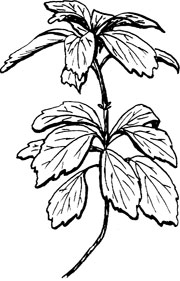 Japanese spurge is a popular ground cover suitable for shady landscape situations. This evergreen plant spreads by underground stems and attains a height of 6 to 8 inches.
Japanese spurge is a popular ground cover suitable for shady landscape situations. This evergreen plant spreads by underground stems and attains a height of 6 to 8 inches.
The foliage is tinged purple in spring, becoming bright green in summer and yellow-green in winter or when planted in sunny locations.
Occasionally, clusters of tiny, off-white blossoms appear above the leaves in early May, but they have little ornamental value.
The plant is adapted to full or partial shade. When planted in full sun, growth is poor. It is one of the few plants that will glow under evergreens and in dense shade. The evergreen leaves commonly “burn” and turn brown in exposed places during the winter.
Established plants are usually planted in the spring 1 foot apart. Clipping the tips of vigorous growing shoots in the spring will induce the plant to become more dense. The plants should not be cut all the way to the ground. The plant prefers a moist, highly organic, well-drained soil for best establishment. A planting of this ground cover is usually a uniform height throughout.
Lily-turf (Liriope spicata, L. muscari)
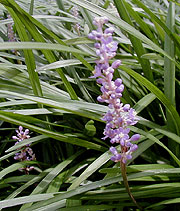 Figure 2. Lily-turf (Liriope spicata).
Figure 2. Lily-turf (Liriope spicata).
Lily-turf is a grasslike evergreen that spreads quickly to form a dense mat. There are two species commonly used as ground covers in large areas. Creeping lily-turf (Liriope spicata, Figure 2), grows 10 to 12 inches tall, forming clumps of dark green, straplike leaves that create an interesting texture in the landscape. In late summer it produces spikes of purple to white flowers, which eventually form clusters of black berries. Creeping lily-turf spreads aggressively by sending out underground stems and can get out of bounds if not contained.
Blue lily-turf (Liriope muscari) is similar in appearance to creeping lily-turf but grows taller (18 inches) and has wider leaf blades. It also produces spikes of blue flowers, but forms clumps that enlarge slowly rather than spreading aggressively like its creeping cousin.
Liriope will grow in either sun or shade. It prefers moist soil with high organic matter content. It will tolerate a wide range of soil conditions but grows more slowly in clay soils. In north Missouri, leaves of both species may look brown and tattered by spring. Appearance can be enhanced by mowing or cutting the plants back to remove unsightly foliage.
Lungwort (Pulmonaria)
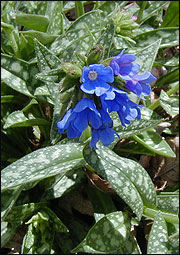 Figure 3. Lungwort (Pulmonaria).
Figure 3. Lungwort (Pulmonaria).
Pulmonarias as a group are easy-to-grow, low-growing perennials that are useful as ground covers in shade. They have interesting, mottled foliage and attractive clusters of blue, purple, pink or white flowers in spring. They spread gradually from the crown, forming large clumps. One popular cultivar, Pulmonaria sacharata ‘Mrs. Moon’, has distinct silvery spots on the leaves and magenta flower buds with flowers turning blue at maturity (Figure 3).
Since they tolerate shade well, pulmonarias are well suited to planting in mulched beds under trees where grass is difficult to grow. When used in this way, regular irrigation may be necessary to help the ground cover compete with shallow tree roots.
Pinks (Dianthus)
Pinks are popular, easy-to-grow, drought-tolerant perennials that generally perform will in full sun. They are best known for their attractive, small carnation-like flowers in spring. One of the best species of Dianthus for ground cover is D. gratianopolitanus, the cheddar pink. It grows 6 to 8 inches tall, forming a dense, grassy mat that produces an abundance of flowers in early spring.
Cheddar pink makes an excellent rock garden plant where perfect soil drainage is assured. Pinks commonly die out in the center after several years and may need to be re-established by transplanting divisions.
Stonecrop (Sedum)
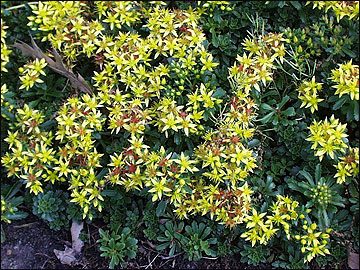 Figure 4. Stonecrop (Sedum).
Figure 4. Stonecrop (Sedum).
There are a number of species and cultivars of sedum that make effective ground covers. All have fleshy, drought resistant leaves and most have colorful flowers. Sedum kamtschaticum (Figure 4), one of the most commonly grown species spreads quickly, forming a dense mat of 6- to 9-inch stems that produce an impressive display of yellow, star-shaped flowers in midsummer. Yellow stonecrop (Sedum reflexum) has similar flowers, but smaller leaves and a shorter stature. Sedums are gaining in popularity and many types, with various leaf sizes, plant heights and leaf and flower colors can be found in garden stores.
Sedums, in general prefer full sun or light shade. They tolerate a wide range of soil conditions as long as drainage is excellent. As the common name implies, they perform well in rock gardens.
Thyme (Thymus)
Two species of thyme are commonly used as ground covers in rock gardens. Creeping thyme (Thymus serphyllum) is a mat-forming perennial with tiny leaves, producing rounded purplish flower heads about 4 inches tall. Stems are woody at the base and spread gradually to form a mat up to 3 feet in diameter. Wooly thyme (T. pseudolanuginosis) is a prostrate plant with tiny, hairy leaves, staying less than one inch tall. If produces few flowers but provides an interesting texture in the garden.
Thymes require a well-drained, sunny location. Unlike most ground covers, they will tolerate some foot traffic and are commonly planted in cracks between stone steps or pavers.
POTENTIALLY INVASIVE GROUND COVERS
Some plants commonly used as ground covers in landscapes grow aggressively and have the potential to spread into natural areas, where they may crowd out existing vegetation. Such aggressive growth may be considered desirable in a landscape setting because it leads to rapid ground cover. However, use of such plants should be avoided in locations where there is a significant risk of escape to natural areas. Commonly used ground cover species that are considered by many people to be “invasive” include English ivy, wintercreeper, crownvetch, ajuga, periwinkle, Liriope spicata and certain types of honeysuckle. Wintercreeper (Euonymus fortunei) poses a significant risk, since it grows well in shade and competes strongly with understory plants in wooded areas. Although several types of wintercreeper sold in garden centers generally do not produce seeds, they can spread rapidly by rooting of runners. Japanese honeysuckle (Lonicera japonica) should not be used as a ground cover because it produces abundant fruit that is attractive to birds, which disperse the seed.
Ajuga, Bugleweed or Carpet bugle (Ajuga reptans)
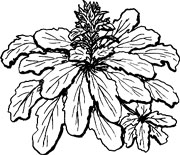 Ajuga forms a dense carpet of foliage over the soil. This semievergreen plant grows rapidly by producing mats of foliage in rosettes. “Runners” develop from the “mother” plants, take root and produce new plants similar to the growth habit of strawberries. The foliage grows about 4 inches high with upright clusters of blue flowers reaching 6 to 8 inches. The plant flowers in early May to mid-June. Ajuga will flourish in almost any soil with good drainage. It grows best in full sun but also tolerates shade.
Ajuga forms a dense carpet of foliage over the soil. This semievergreen plant grows rapidly by producing mats of foliage in rosettes. “Runners” develop from the “mother” plants, take root and produce new plants similar to the growth habit of strawberries. The foliage grows about 4 inches high with upright clusters of blue flowers reaching 6 to 8 inches. The plant flowers in early May to mid-June. Ajuga will flourish in almost any soil with good drainage. It grows best in full sun but also tolerates shade.
The foliage is deep green in color and partly evergreen, turning brown after severe freezing weather. Bronze and variegated cultivars are also available. The extensive root system prevents soil erosion.
If established plants are set apart in the spring, they will cover the soil in one growing season. Do not set the plants too deep. The crown should never be covered. In the spring or early fall, rooted "runner plants" can be dug from established plantings and replanted elsewhere.
Crownvetch (Coronilla varia)
Crownvetch is a perennial legume used frequently to cover dry, steep, rocky slopes. The plant grows 1 to 2 feet tall and bears small pink flowers from July to September. The plant spreads by underground stems and one plant can cover an area up to 6 feet in diameter. It tolerates shade but thrives in full sun. The foliage dies to the ground by December.
Crownvetch is most valued for its ability to prevent soil erosion. It is often used for this purpose on highway slopes. The plant is suited for covering large areas and is too vigorous for small sections of the landscape.
The plant is propagated either from crowns or by seeding. Crowns planted 2 feet apart will provide coverage in about two years. One crown per square foot is recommended for quick cover. Seeding should be at the rate of 1/2 pound per 1,000 square feet. The seed should be inoculated to introduce bacteria for nitrogen fixation. The seed can be sown without seedbed preparation into weedy, grassy areas if necessary.
Both crowns and seed may be planted any time during the year.
English ivy (Hedera helix)
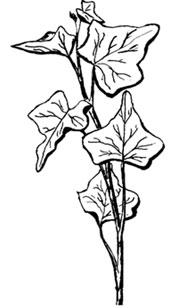 English ivy is an evergreen creeping vine forming a dense mat of dark green foliage 6 to 8 inches tall. The plant grows best in shade or semi-shaded locations. It is most useful on north- and east-facing banks, under trees where grass will not grow or as an underplanting between shrubs. If exposed to full sun or sweeping winds, the foliage "burns" in the winter. Although it can be planted 1 foot apart for cover in one year, it is more economical to transplant growing plants from pots or flats in the spring at a spacing of 18 to 24 inches. Vines may grow about 3 feet the first season. When used next to buildings or walls, English ivy will climb, clinging by means of aerial rootlets. This may be an asset or fault depending upon the situation and personal preference.
English ivy is an evergreen creeping vine forming a dense mat of dark green foliage 6 to 8 inches tall. The plant grows best in shade or semi-shaded locations. It is most useful on north- and east-facing banks, under trees where grass will not grow or as an underplanting between shrubs. If exposed to full sun or sweeping winds, the foliage "burns" in the winter. Although it can be planted 1 foot apart for cover in one year, it is more economical to transplant growing plants from pots or flats in the spring at a spacing of 18 to 24 inches. Vines may grow about 3 feet the first season. When used next to buildings or walls, English ivy will climb, clinging by means of aerial rootlets. This may be an asset or fault depending upon the situation and personal preference.
Where winters are severe, ivy cultivars used for ground cover should be the hardiest available. Examples of the hardiest varieties include ‘Baltica’, ‘Bulgaria’ and ‘Thorndale’.
Periwinkle, Myrtle or Vinca (Vinca minor)
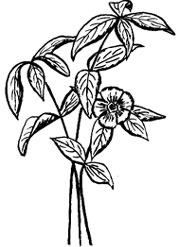 Periwinkle or myrtle is an excellent evergreen ground cover with dark green foliage and purple, blue or white flowers depending on the variety. It blooms in April and sometimes again in the fall. The plant grows about 6 inches tall, spreading in all directions by sending out long trailing and rooting shoots which make new plants.
Periwinkle or myrtle is an excellent evergreen ground cover with dark green foliage and purple, blue or white flowers depending on the variety. It blooms in April and sometimes again in the fall. The plant grows about 6 inches tall, spreading in all directions by sending out long trailing and rooting shoots which make new plants.
It likes shade but will grow satisfactorily in full sun. The foliage color is richer green in partial shade, but more flowers are produced in the sun.
This ground cover is most commonly used for underplanting trees and shrubs, on shaded slopes or on the north side of buildings.
Rooted cuttings or established plants are normally spaced from 12 to 18 inches apart. At a 6-inch spacing, a complete cover will be produced in one year. Plant in the spring in areas with severe winters.
Spring-flowering bulbs interplanted with periwinkle will lend color and interest to the ground cover planting. Daffodils are particularly well suited because they bloom with vinca and do not require frequent division.
Purple wintercreeper (Euonymus fotunei var. coloratus)
 Purple wintercreeper is an evergreen plant that is effective for covering relatively large areas, banks, slopes and shaded areas under trees. The plant produces glossy green leaves that turn purple in the fall. It sends out prostrate stems, which root where they contact moist soil. It will cling to vertical walls and surfaces it contacts. When established, this ground cover forms a loose, somewhat irregular network of stems to a height of 8 to 12 inches. Its deep rooting habit makes it a good soil binder.
Purple wintercreeper is an evergreen plant that is effective for covering relatively large areas, banks, slopes and shaded areas under trees. The plant produces glossy green leaves that turn purple in the fall. It sends out prostrate stems, which root where they contact moist soil. It will cling to vertical walls and surfaces it contacts. When established, this ground cover forms a loose, somewhat irregular network of stems to a height of 8 to 12 inches. Its deep rooting habit makes it a good soil binder.
Although an aggressive grower, purple wintercreeper rarely blooms in the landscape and is considered to be non-fruiting. Thus, unlike the species, it less likely to become invasive. Be aware that a pest known as euonymus scale often attacks purple wintercreeper and might require control measures.
Some pruning of upright growing shoots helps to keep the ground cover lower and more compact. The plant grows well in sun or shade. As noted previously, the species (E. fortunei) is considered an invasive plant my most states and should not be used in the landscape.
Original author
R.R. Rothenberger